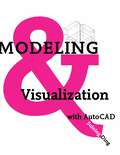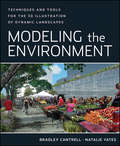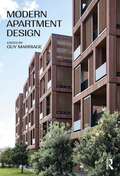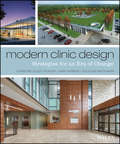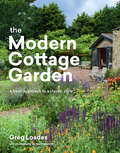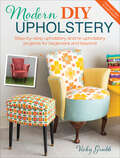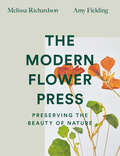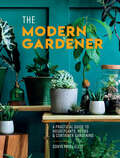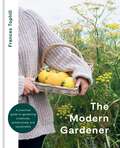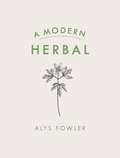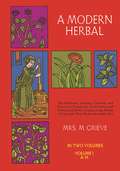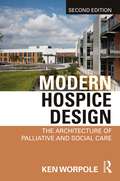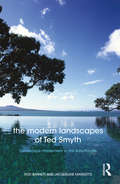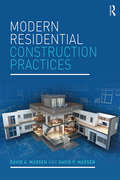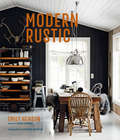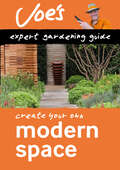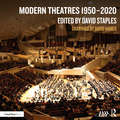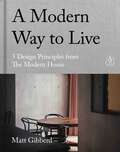- Table View
- List View
Modeling and Visualization with AutoCAD
by Suining DingInterior designers use AutoCAD software for their drafting and rendering, but where do they learn to apply basic AutoCAD drafting standards and procedures to their specific needs? Modeling and Visualization with AutoCAD answers the question with tutorials that show students how to use AutoCAD software for such drawings as floor plans, reflected ceiling plans, interior elevations, and casework sections. Covering both 2-D and 3-D AutoCAD, the book introduces the method of importing digital images into the material library. This book introduces AutoCAD in a generic way to accommodate the minor differences between newer and older versions; the emphasis is on typical procedures and methods rather than a more detailed process. Its case studies use ancient and modern masterpieces of interior design to demonstrate various applications so that students cannot only develop their rendering skills in a creative way, but also build upon their knowledge and appreciation of the classical elements of design.Features-- Easy to follow step-by-step tutorials for different levels of learners-- Chapter objectives, key terms, and exercises to help students practice what they have learned-- Integration of instructions for applying AutoCAD functions to interior design and presentation of masterpieces that enhance learners' appreciation of classical architectural forms-- Full color illustrations created with the most recent version of AutoCAD to demonstrate results that can also be achieved with earlier versions-- Instructor's Guide provides suggestions for planning the course and using the text in the classroom
Modeling the Environment: Techniques and Tools for the 3D Illustration of Dynamic Landscapes
by Bradley Cantrell Natalie YatesA single-source guide to harnessing the power of 3D visualization tools for analysis and representation of landscapes Current technology allows designers to model environmental phenomena and space in new and exciting ways that go beyond the two-dimensional plane. The models, illustrations, and animations that can be created usher in a new paradigm of landscape representation that can become analytical tools as well as beautiful imagery. The text focuses on digital modeling methods that can be used to express rich environments using digital tools to develop, composite, and animate scenes. This full-color book provides coverage of 3D visualization tools for land planning and landscape architecture. The methods and theories in Modeling the Environment present landscape representation around a core set of ideas—scene, object, terrain, environment/atmosphere, time/dynamics, and the composite—that centers representation on human experience. Supported by www.lab.visual-logic.com, a website offering tutorials and forums, the text shows you how to use Autodesk 3ds Max to create dynamic landscape environments while also referring to a range of other tools including Google SketchUp, Autodesk Maya, and AutoCAD Civil 3D. It also demonstrates how to integrate 3D visualization tools into existing workflows, and offers critical coverage of intelligent drawings and representations, giving you a glimpse at the future of the profession. This book: Includes sections intended to build upon one another in order to understand the environment as a composite representation of multiple systems interacting Shows how to integrate 3D visualization tools into existing workflows, as opposed to offering an entirely new workflow Emphasizes modeling, animation, and simulation as both design analysis tools and presentation tools Modeling the Environment is essential reading for professionals in landscape architecture, urban planning and design, architecture, and related disciplines who are looking to be at the forefront of technology.
Modeling the Environment: Techniques and Tools for the 3D Illustration of Dynamic Landscapes
by Bradley Cantrell Natalie YatesA single-source guide to harnessing the power of 3D visualization tools for analysis and representation of landscapes Current technology allows designers to model environmental phenomena and space in new and exciting ways that go beyond the two-dimensional plane. The models, illustrations, and animations that can be created usher in a new paradigm of landscape representation that can become analytical tools as well as beautiful imagery. The text focuses on digital modeling methods that can be used to express rich environments using digital tools to develop, composite, and animate scenes. This full-color book provides coverage of 3D visualization tools for land planning and landscape architecture. The methods and theories in Modeling the Environment present landscape representation around a core set of ideas—scene, object, terrain, environment/atmosphere, time/dynamics, and the composite—that centers representation on human experience. Supported by www.lab.visual-logic.com, a website offering tutorials and forums, the text shows you how to use Autodesk 3ds Max to create dynamic landscape environments while also referring to a range of other tools including Google SketchUp, Autodesk Maya, and AutoCAD Civil 3D. It also demonstrates how to integrate 3D visualization tools into existing workflows, and offers critical coverage of intelligent drawings and representations, giving you a glimpse at the future of the profession. This book: Includes sections intended to build upon one another in order to understand the environment as a composite representation of multiple systems interacting Shows how to integrate 3D visualization tools into existing workflows, as opposed to offering an entirely new workflow Emphasizes modeling, animation, and simulation as both design analysis tools and presentation tools Modeling the Environment is essential reading for professionals in landscape architecture, urban planning and design, architecture, and related disciplines who are looking to be at the forefront of technology.
Modern Apartment Design
by Guy MarriageModern Apartment Design provides guidelines to the design of modern apartment buildings as well as a summation of current cutting-edge practice in engineered timber construction. The book covers a brief history of apartment buildings around the world, with a broad outline of different types of apartment blocks. It has a strong focus on the design and actual construction of apartment buildings, especially those utilising mass timber, such as cross-laminated timber and laminated veneer lumber. It also features six Case Study chapters from industry-leading practitioners in the area, enabling best practice in architecture and engineering of these new apartment building types to be more widely understood and propagated worldwide. The fully illustrated, full-colour case studies span the globe and include: Clearwater Quay in Christchurch, New Zealand (Pacific Environments NZ); Wynyard Central East 2 in Auckland, New Zealand (Architectus); Dalton Works in London, UK (Waugh Thistleton Architects); Mjøstårnet, Brumunddal, Norway (Voll Arkitekter); Brock Commons Tallwood House student housing in Vancouver, Canada (Acton Ostry Architects); and Regensbergstrasse apartments in Zurich, Switzerland (Dreicon). The book will be of great interest to architects and architecture students.
Modern Apartment Design
by Guy MarriageModern Apartment Design provides guidelines to the design of modern apartment buildings as well as a summation of current cutting-edge practice in engineered timber construction. The book covers a brief history of apartment buildings around the world, with a broad outline of different types of apartment blocks. It has a strong focus on the design and actual construction of apartment buildings, especially those utilising mass timber, such as cross-laminated timber and laminated veneer lumber. It also features six Case Study chapters from industry-leading practitioners in the area, enabling best practice in architecture and engineering of these new apartment building types to be more widely understood and propagated worldwide. The fully illustrated, full-colour case studies span the globe and include: Clearwater Quay in Christchurch, New Zealand (Pacific Environments NZ); Wynyard Central East 2 in Auckland, New Zealand (Architectus); Dalton Works in London, UK (Waugh Thistleton Architects); Mjøstårnet, Brumunddal, Norway (Voll Arkitekter); Brock Commons Tallwood House student housing in Vancouver, Canada (Acton Ostry Architects); and Regensbergstrasse apartments in Zurich, Switzerland (Dreicon). The book will be of great interest to architects and architecture students.
Modern Clinic Design: Strategies for an Era of Change
by Christine Guzzo Vickery Gary Nyberg Douglas WhiteakerShift Clinic design to keep pace with the evolving healthcare industry Modern Clinic Design: Strategies for an Era of Change is a comprehensive guide to optimizing patient experience through the design of the built environment. Written by a team of veteran healthcare interior designers, architects, and engineers, this book addresses the impacts of evolving legislation, changing technologies, and emerging nontraditional clinic models on clinic design, and illustrates effective design strategies for any type of clinic. Readers will find innovative ideas about lean design, design for flexibility, and the use of mock-ups to prototype space plans within a clinic setting, and diagrammed examples including waiting rooms, registration desks, and exam rooms that demonstrate how these ideas are applied to real-world projects. Spurred on by recent healthcare legislation and new technological developments, clinics can now offer a greater variety of services in a greater variety of locations. Designers not only need to know the different requirements for each of these spaces, but also understand how certain design strategies affect the patient's experience in the space. This book explores all aspects of clinic design, and describes how aesthetics and functionality can merge to provide a positive experience for patients, staff, and healthcare providers. Understand how recent industry developments impact facility design Learn how design strategies can help create a positive patient experience Examine emerging clinic models that are becoming increasingly prevalent Analyze the impact of technology on clinic design A well-designed clinic is essential for the well-being of the patients and health care providers that occupy the space every day. The healthcare industry is shifting, and the healthcare design industry must shift with it to continue producing spaces that are relevant to ever-evolving patient and worker needs. For complete guidance toward the role of design, Modern Clinic Design is a thorough, practical reference.
Modern Clinic Design: Strategies for an Era of Change
by Christine Guzzo Vickery Gary Nyberg Douglas WhiteakerShift Clinic design to keep pace with the evolving healthcare industry Modern Clinic Design: Strategies for an Era of Change is a comprehensive guide to optimizing patient experience through the design of the built environment. Written by a team of veteran healthcare interior designers, architects, and engineers, this book addresses the impacts of evolving legislation, changing technologies, and emerging nontraditional clinic models on clinic design, and illustrates effective design strategies for any type of clinic. Readers will find innovative ideas about lean design, design for flexibility, and the use of mock-ups to prototype space plans within a clinic setting, and diagrammed examples including waiting rooms, registration desks, and exam rooms that demonstrate how these ideas are applied to real-world projects. Spurred on by recent healthcare legislation and new technological developments, clinics can now offer a greater variety of services in a greater variety of locations. Designers not only need to know the different requirements for each of these spaces, but also understand how certain design strategies affect the patient's experience in the space. This book explores all aspects of clinic design, and describes how aesthetics and functionality can merge to provide a positive experience for patients, staff, and healthcare providers. Understand how recent industry developments impact facility design Learn how design strategies can help create a positive patient experience Examine emerging clinic models that are becoming increasingly prevalent Analyze the impact of technology on clinic design A well-designed clinic is essential for the well-being of the patients and health care providers that occupy the space every day. The healthcare industry is shifting, and the healthcare design industry must shift with it to continue producing spaces that are relevant to ever-evolving patient and worker needs. For complete guidance toward the role of design, Modern Clinic Design is a thorough, practical reference.
The Modern Cottage Garden: A Fresh Approach to a Classic Style
by Greg LoadesThis design-forward guide teaches gardeners how to blend the best aspects of two important styles: the traditional cottage garden and the New Perennial movement.
Modern DIY Upholstery: Step-by-Step Upholstery and Reupholstery Projects for Beginners and Beyond
by Vicky GrubbModern DIY Upholstery shows the hobby sewer or complete newcomer how to make the leap into home upholstery taking you gently by the hand, demonstrating the simple techniques you need to bring your love of fabric to upholstered items for the home. Not a dry, highly technical professional upholstery manual, this bright and accessible book presents 10 simple projects using modern methods that are quick and easy to achieve. You will be taken step-by-step through the process of upholstery of desirable pieces of furniture – using items found at antique markets, street sales and thrift stores that are designed up and given a modern twist. You will then learn all about fabric choice and other materials, discover the essential techniques and then embark on the projects which include a simple stool, a vintage sewing box, a blanket box or ottoman, a fluted headboard, a Danish dining chair, a bedroom/nursing chair, a patchwork armchair and a mid-century design two-seater sofa, all guided by the author's expert instruction. QR codes will take you to time-lapse videos of the construction of each project – the only book to attempt such a feat!
The Modern Flower Press: Preserving The Beauty Of Nature
by Melissa Richardson Amy FieldingA contemporary, beautifully illustrated book on flowers, flower pressing and arranging.
The Modern Gardener: A Practical Guide To Houseplants, Herbs And Container Gardening
by Sonya Patel EllisWelcome to modern matchmaking – for plants! All you need to do is be honest about what you can invest into your plant relationship (attentiveness, experience … sunlight) and voila – The Modern Gardener will suggest the best matched plant partner for you.
The Modern Gardener: A practical guide to gardening creatively, productively and sustainably
by Frances Tophill'Frances Tophill is not only a qualified horticulturalist but is fast becoming the fresh new face of television gardening.' Daily MailWe no longer just want to garden, we want to engage with the land; the plants in it, the animals, insects and even the fungi. The Modern Gardener isn't just about creating a space that simply looks visually stunning, but about encouraging wildlife, reducing our carbon footprint and making our outdoor and indoor space more useful in all areas of our lives. As well as how to select and grow your plants, there is also information for how to design your garden alongside a variety of plant-based recipes - from delicious drinks to natural dyes - that can easily be made at home.
A Modern Herbal
by Alys FowlerPlant-based medicine for a calmer, healthier life It's easy to turn to the pharmacy when we're stressed, sick or feeling under the weather, but what if you turned to your garden instead?In this accessible and easy to use manual, horticultural expert, former Gardener's World presenter and Guardiancolumnist, Alys Fowler, shows how to take control of your health by adopting a more natural lifestyle. For thousands of years, people who had no access to clinical medicine knew how to boost their well-being by using the ingredients they found in plants. Herbs are the people's medicine; often freely available and abundant, they are ready and waiting to be plucked from around you to soothe and heal your body and mind. With guides for how to use and grow over 100 herbs - for example how to use fennel for indigestion, camomile for anxiety and nettle for hayfever - you'll soon be heading into the garden, rather than opening the medicine cabinet. Offering a fusion of botanical, practical, cultural and historical information, A Modern Herbal reveals how common herbs are the simple, cleansing way to better health and happiness.AS SEEN IN THE GUARDIAN
A Modern Herbal
by Margaret GrieveIf you want to know how pleurisy root, lungwort, and abscess root got their names, how poison ivy used to treat rheumatism, or how garlic guarded against the Bubonic Plague, consult A Modern Herbal. This 20th-century version of the medieval Herbal is as rich in scientific fact and folklore as its predecessors and is equally encyclopedic in coverage. From aconite to zedoary, not an herb, grass, fungus, shrub or tree is overlooked; and strange and wonderful discoveries about even the most common of plants await the reader.Traditionally, an herbal combined the folk beliefs and tales about plants, the medicinal properties (and parts used) of the herbs, and their botanical classification. But Mrs. Grieve has extended and enlarged the tradition; her coverage of asafetida, bearberry, broom, chamomile, chickweed, dandelion, dock, elecampane, almond, eyebright, fenugreek, moss, fern, figwort, gentian, Hart's tongue, indigo, acacia, jaborandi, kava kava, lavender, pimpernel, rhubarb, squill, sage, thyme, sarsaparilla, unicorn root, valerian, woundwort, yew, etc. — more than 800 varieties in all — includes in addition methods of cultivation; the chemical constituents, dosages, and preparations of extracts and tinctures, unknown to earlier herbalists; possible economic and cosmetic properties, and detailed illustrations, from root to bud, of 161 plants.Of the many exceptional plants covered in Herbal, perhaps the most fascinating are the poisonous varieties — hemlock, poison oak, aconite, etc. — whose poisons, in certain cases, serve medical purposes and whose antidotes (if known) are given in detail. And of the many unique features, perhaps the most interesting are the hundreds of recipes and instructions for making ointments, lotions, sauces, wines, and fruit brandies like bilberry and carrot jam, elderberry and mint vinegar, sagina sauce, and cucumber lotion for sunburn; and the hundreds of prescriptions for tonics and liniments for bronchitis, arthritis, dropsy, jaundice, nervous tension, skin disease, and other ailments. 96 plates, 161 illustrations.
Modern Hospice Design: The Architecture of Palliative and Social Care
by Ken WorpoleThe new edition of this acclaimed book comprehensively updates its timely advocacy of the need for good quality palliative care, today more necessary than ever. Rooted in the social history of the care of the elderly and terminally ill, Modern Hospice Design: The Architecture of Palliative and Social Care takes cognisance of the new conditions of social care in the 21st century, principally in the UK, Europe and North America. It does so with regard to the development of new building types, but also in response to new philosophies of palliative care and the status of the elderly and the dying. Benefitting from a clearer methodological approach and conceptual framework, the expanded book allows a broad section of readers to navigate the text more easily. At its core is a public discussion of a philosophy of design for providing care for the elderly and the vulnerable, taking the importance of architectural aesthetics, the use of quality materials, the porousness of design to the wider world, and the integration of indoor and outdoor spaces as part of the overall care environment. In doing so it advocates care settings that, in the words of Maggie Jencks whose life and ideas inspired the Maggie’s Centres, ‘rise to the occasion’. Including new chapters and new in-depth case studies, complete will full colour illustrations, this book is for architects and interior designers and their students, healthcare professionals, social care providers, estate and facility managers, hospital administrators and Healthcare Trust Boards.
Modern Hospice Design: The Architecture of Palliative and Social Care
by Ken WorpoleThe new edition of this acclaimed book comprehensively updates its timely advocacy of the need for good quality palliative care, today more necessary than ever. Rooted in the social history of the care of the elderly and terminally ill, Modern Hospice Design: The Architecture of Palliative and Social Care takes cognisance of the new conditions of social care in the 21st century, principally in the UK, Europe and North America. It does so with regard to the development of new building types, but also in response to new philosophies of palliative care and the status of the elderly and the dying. Benefitting from a clearer methodological approach and conceptual framework, the expanded book allows a broad section of readers to navigate the text more easily. At its core is a public discussion of a philosophy of design for providing care for the elderly and the vulnerable, taking the importance of architectural aesthetics, the use of quality materials, the porousness of design to the wider world, and the integration of indoor and outdoor spaces as part of the overall care environment. In doing so it advocates care settings that, in the words of Maggie Jencks whose life and ideas inspired the Maggie’s Centres, ‘rise to the occasion’. Including new chapters and new in-depth case studies, complete will full colour illustrations, this book is for architects and interior designers and their students, healthcare professionals, social care providers, estate and facility managers, hospital administrators and Healthcare Trust Boards.
The Modern Landscapes of Ted Smyth: Landscape Modernism in the Asia-Pacific
by Jacqueline Margetts Rod BarnettThe modern period in landscape architecture is enjoying the fascinated appreciation of scholars and historians in Europe and the Americas, and new themes, new subjects and new appraisals are appearing. This book contributes to the conversation by focusing on the work of a singular designer who spent his entire career in a province of the North Island of New Zealand. Ted Smyth practiced an assured landscape modernism without ever seeing the designs of his forebears or his contemporaries working in the UK, Europe and the United States. Designing in isolation from the mainstream of modernism, and a little after its high tide, Smyth produced a series of gardens that provoke a revaluation of the diffusionist model of influence. The book explains and describes the evolution of Smyth’s design vocabulary and relates it to the development of tropical landscape modernism in other Asia-Pacific sites. It shows how a culture of garden modernism can be generated from within a particular locale, and highlights Smyth’s engagement with Māori design traditions in search of a specific expression of the high modern essentialism of place.
The Modern Landscapes of Ted Smyth: Landscape Modernism in the Asia-Pacific
by Jacqueline Margetts Rod BarnettThe modern period in landscape architecture is enjoying the fascinated appreciation of scholars and historians in Europe and the Americas, and new themes, new subjects and new appraisals are appearing. This book contributes to the conversation by focusing on the work of a singular designer who spent his entire career in a province of the North Island of New Zealand. Ted Smyth practiced an assured landscape modernism without ever seeing the designs of his forebears or his contemporaries working in the UK, Europe and the United States. Designing in isolation from the mainstream of modernism, and a little after its high tide, Smyth produced a series of gardens that provoke a revaluation of the diffusionist model of influence. The book explains and describes the evolution of Smyth’s design vocabulary and relates it to the development of tropical landscape modernism in other Asia-Pacific sites. It shows how a culture of garden modernism can be generated from within a particular locale, and highlights Smyth’s engagement with Māori design traditions in search of a specific expression of the high modern essentialism of place.
Modern Residential Construction Practices
by David A. Madsen David P. MadsenModern Residential Construction Practices provides easy-to-read, comprehensive and highly illustrated coverage of residential building construction practices that conform to industry standards in the United States and Canada. Each chapter provides complete descriptions, real-world practices, realistic examples, three-dimensional (3D) illustrations, and related tests and problems. Chapters cover practices related to every construction phase including: planning, funding, permitting, codes, inspections, site planning, excavation, foundations and flatwork, floors, walls, roofs, finish work and cabinetry; heating, ventilating, and air conditioning (HVAC); electrical, and plumbing. The book is organized in a format that is consistent with the process used to take residential construction projects from preliminary concept through all phases of residential building construction. An ideal textbook for secondary and college level construction programs, the book is packed with useful features such as problems that challenge students to identify materials and practices, along with research and document information about construction materials and practices, useful summaries, key notes, a detailed glossary, and online materials for both students and educators.
Modern Residential Construction Practices
by David A. Madsen David P. MadsenModern Residential Construction Practices provides easy-to-read, comprehensive and highly illustrated coverage of residential building construction practices that conform to industry standards in the United States and Canada. Each chapter provides complete descriptions, real-world practices, realistic examples, three-dimensional (3D) illustrations, and related tests and problems. Chapters cover practices related to every construction phase including: planning, funding, permitting, codes, inspections, site planning, excavation, foundations and flatwork, floors, walls, roofs, finish work and cabinetry; heating, ventilating, and air conditioning (HVAC); electrical, and plumbing. The book is organized in a format that is consistent with the process used to take residential construction projects from preliminary concept through all phases of residential building construction. An ideal textbook for secondary and college level construction programs, the book is packed with useful features such as problems that challenge students to identify materials and practices, along with research and document information about construction materials and practices, useful summaries, key notes, a detailed glossary, and online materials for both students and educators.
Modern Rustic
by Emily HensonRustic isn’t what it used to be. Gone are the days when rustic style meant fusty dried flower arrangements, antlers over a stone fireplace and acres of tartan.At its heart, the modern rustic look celebrates the fabric of a home, from the roof beams to the brickwork. This style revels in earthy colours and rich textures; in natural materials such as wood and stone; and the ruggedly handsome bones of a building. In this book, stylist Emily Henson and writer Joanna Simmons first lead you through the Elements of the Modern Rustic look. Pure Rustic elegantly blends clean lines with muted shades of grey. Bohemian Rustic mixes texture and pattern with lush colour, while Pop Rustic teams raw wood with pops of neon and tongue-in-cheek artworks. Retro Rustic, meanwhile, brings a relaxed feel, showcasing beaten-up leather armchairs and brick floors. In Details, textiles, furniture, fabric and display are explored, while Living Spaces shows how Modern Rustic style translates beautifully to every room in the house.
Modern Space: Create Your Own Green Space With This Expert Gardening Guide (Collins Gardening)
by Joe Swift Collins BooksDesign your own modern green space with expert gardener Joe Swift. Gardens connect us with the natural world, improve our physical and mental health, and allow us to showcase our personalities. Expert gardener Joe Swift’s practical, easy-to-follow advice will inspire readers to envision what is possible in even the smallest spaces.
Modern Theatres 1950–2020
by David Staples; David HamerModern Theatres 1950–2020 is an investigation of theatres, concert halls and opera houses in Asia, Europe, the Middle East and North and South America. The book explores in detail 30 of the most significant theatres, concert halls, opera houses and dance spaces that opened between 1950 and 2010. Each theatre is reviewed and assessed by experts in theatre buildings, such as architects, acousticians, consultants and theatre practitioners, and illustrated with full-colour photographs and comparative plans and sections. A further 20 theatres that opened from 2009 to 2020 are concisely reviewed and illustrated. An excellent resource for students of theatre planning, theatre architecture and architectural design, Modern Theatres 1950–2020 discusses the role of performing arts buildings in cities, explores their public and performances spaces and examines the acoustics and technologies needed in a great building.
Modern Theatres 1950–2020
by David StaplesModern Theatres 1950–2020 is an investigation of theatres, concert halls and opera houses in Asia, Europe, the Middle East and North and South America. The book explores in detail 30 of the most significant theatres, concert halls, opera houses and dance spaces that opened between 1950 and 2010. Each theatre is reviewed and assessed by experts in theatre buildings, such as architects, acousticians, consultants and theatre practitioners, and illustrated with full-colour photographs and comparative plans and sections. A further 20 theatres that opened from 2009 to 2020 are concisely reviewed and illustrated. An excellent resource for students of theatre planning, theatre architecture and architectural design, Modern Theatres 1950–2020 discusses the role of performing arts buildings in cities, explores their public and performances spaces and examines the acoustics and technologies needed in a great building.
A Modern Way to Live: 5 Design Principles from The Modern House
by Matt GibberdFind happiness at home with five guiding principles from cultural phenomenon THE MODERN HOUSE.'A source of fascination, inspiration and fantasy' GuardianIn 2005, childhood friends Matt Gibberd and Albert Hill set out to convince people of the power of good design and its ability to influence our wellbeing. They founded The Modern House - in equal parts an estate agency, a publisher and a lifestyle brand - and went on to inspire a generation to live more thoughtfully and beautifully at home. As The Modern House grew, Matt and Albert came to realise that the most successful homes they encountered - from cleverly conceived studio flats to listed architectural masterpieces - had been designed with attention to the same timeless principles: Space, Light, Materials, Nature and Decoration.In this lavishly illustrated book, Matt tells the stories of these remarkable living spaces and their equally remarkable owners, and demonstrates how the five principles can be applied to your own space in ways both large and small. Revolutionary in its simplicity, and full of elegance, humour and joy, this book will inspire you to find happiness in the place you call home.PRAISE FOR THE MODERN HOUSE:'One of the best things in the world' GQ'The Modern House transformed our search for the perfect home' Financial Times'Nowhere has mastered the art of showing off the most desirable homes for both buyers and casual browsers alike than The Modern House' Vogue
